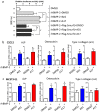Selective small molecule compounds increase BMP-2 responsiveness by inhibiting Smurf1-mediated Smad1/5 degradation
- PMID: 24828823
- PMCID: PMC4021816
- DOI: 10.1038/srep04965
Selective small molecule compounds increase BMP-2 responsiveness by inhibiting Smurf1-mediated Smad1/5 degradation
Abstract
The ubiquitin ligase Smad ubiquitination regulatory factor-1 (Smurf1) negatively regulates bone morphogenetic protein (BMP) pathway by ubiquitinating certain signal components for degradation. Thus, it can be an eligible pharmacological target for increasing BMP signal responsiveness. We established a strategy to discover small molecule compounds that block the WW1 domain of Smurf1 from interacting with Smad1/5 by structure based virtual screening, molecular experimental examination and cytological efficacy evaluation. Our selected hits could reserve the protein level of Smad1/5 from degradation by interrupting Smurf1-Smad1/5 interaction and inhibiting Smurf1 mediated ubiquitination of Smad1/5. Further, these compounds increased BMP-2 signal responsiveness and the expression of certain downstream genes, enhanced the osteoblastic activity of myoblasts and osteoblasts. Our work indicates targeting Smurf1 for inhibition could be an accessible strategy to discover BMP-sensitizers that might be applied in future clinical treatments of bone disorders such as osteopenia.
Figures







Similar articles
-
Molecular interaction between Smurf1 WW2 domain and PPXY motifs of Smad1, Smad5, and Smad6--modeling and analysis.J Biomol Struct Dyn. 2007 Aug;25(1):11-23. J Biomol Struct Dyn. 2007. PMID: 17676934
-
Involvement of BMPs/Smad signaling pathway in mechanical response in osteoblasts.Cell Physiol Biochem. 2010;26(6):1093-102. doi: 10.1159/000323987. Epub 2011 Jan 4. Cell Physiol Biochem. 2010. PMID: 21220940
-
Bone morphogenetic protein 2 activates Smad6 gene transcription through bone-specific transcription factor Runx2.J Biol Chem. 2007 Apr 6;282(14):10742-8. doi: 10.1074/jbc.M610997200. Epub 2007 Jan 10. J Biol Chem. 2007. PMID: 17215250 Free PMC article.
-
Pharmaceutical perspectives of HECT-type ubiquitin ligase Smurf1.Curr Pharm Des. 2013;19(18):3226-33. doi: 10.2174/1381612811319180007. Curr Pharm Des. 2013. PMID: 23151141 Review.
-
A Smurf1 tale: function and regulation of an ubiquitin ligase in multiple cellular networks.Cell Mol Life Sci. 2013 Jul;70(13):2305-17. doi: 10.1007/s00018-012-1170-7. Epub 2012 Sep 25. Cell Mol Life Sci. 2013. PMID: 23007848 Free PMC article. Review.
Cited by
-
BMP Antagonist Gremlin 2 Limits Inflammation After Myocardial Infarction.Circ Res. 2016 Jul 22;119(3):434-49. doi: 10.1161/CIRCRESAHA.116.308700. Epub 2016 Jun 9. Circ Res. 2016. PMID: 27283840 Free PMC article.
-
HECT E3 Ligases: A Tale With Multiple Facets.Front Physiol. 2019 Apr 3;10:370. doi: 10.3389/fphys.2019.00370. eCollection 2019. Front Physiol. 2019. PMID: 31001145 Free PMC article. Review.
-
Increased Kindlin-2 via SMURF1 Inhibition Attenuates Endothelial Permeability and Acute Lung Injury.Int J Mol Sci. 2025 Feb 22;26(5):1880. doi: 10.3390/ijms26051880. Int J Mol Sci. 2025. PMID: 40076507 Free PMC article.
-
MHC Class I Downregulation in Cancer: Underlying Mechanisms and Potential Targets for Cancer Immunotherapy.Cancers (Basel). 2020 Jul 2;12(7):1760. doi: 10.3390/cancers12071760. Cancers (Basel). 2020. PMID: 32630675 Free PMC article. Review.
-
Biological Effects of Phosphocitrate on Osteoarthritic Articular Chondrocytes.Open Rheumatol J. 2017 May 31;11:62-74. doi: 10.2174/1874312901711010062. eCollection 2017. Open Rheumatol J. 2017. PMID: 28659999 Free PMC article.
References
-
- Chen D., Zhao M. & Mundy G. R. Bone morphogenetic proteins. Growth Factors 22, 233–241 (2004). - PubMed
-
- Ackerman S. J., Mafilios M. S. & Polly D. W. Jr Economic evaluation of bone morphogenetic protein versus autogenous iliac crest bone graft in single-level anterior lumbar fusion: an evidence-based modeling approach. Spine (Phila Pa 1976) 27, S94–99 (2002). - PubMed
-
- Boden S. D., Kang J., Sandhu H. & Heller J. G. Use of recombinant human bone morphogenetic protein-2 to achieve posterolateral lumbar spine fusion in humans: a prospective, randomized clinical pilot trial: 2002 Volvo Award in clinical studies. Spine (Phila Pa 1976) 27, 2662–2673 (2002). - PubMed
Publication types
MeSH terms
Substances
LinkOut - more resources
Full Text Sources
Other Literature Sources

